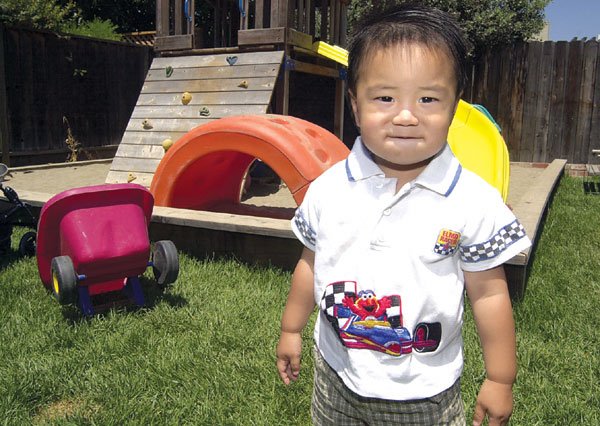As his wife Cari gave birth last week, Scott Joines was snapping away with a camera, but how, he wondered, would the pictures come out? If something happened to the film or the developer screwed up, what could he do? What if they got destroyed?
“Pictures like that you can’t get back,”said Joines, a professional photographer in Morgan Hill. “It sounds a little paranoid, but I took several rolls of film so I could take one in (for development) the first day and another one four days later, then another. That way, if something happened to the machine or the negatives, I’d only lose one roll.”
Paranoid, yes. But for parents capturing their children’s first moments, important, because the only thing worse than the disappointment of bad pictures is not recording the moment at all. Poor framing, bad lighting and general inexperience have ruined many a picture, but we’ve tracked down a couple of local professionals full of advice.
No matter how unlikely, accidents do happen. Unfailingly, at some point you’ll forget to put in your film or have a battery die and realize that the replacement is dead, too. But the most important thing a parent can do to ensure great pictures every time, aside from remembering the basics, is to be prepared with the right equipment, said Joines.
Equipment
“Every step you take affects your images, so use quality products from start to finish,”said Joines, who has owned Custom Creations Photography in Morgan Hill for 12 years with his wife. “If you use great film and processing, but you have a cheap camera, the shots won’t be that great. If you have a great camera but you’re using shoddy film, they won’t turn out any better.”
Joines recommended using Fuji or Kodak film. Fuji’s colors tend to be more vibrant than Kodak’s, he said, but preference for one or the other “is kind of like Coke versus Pepsi. Either way, you’re getting good product.”
The next step toward quality prints is processing. Get to know your photo processor, Joines recommended.
“You take it to (some stores) and you have a 17-year-old kid who couldn’t care less about your stuff,” said Joines. “He’s just there to collect his $7 an hour. If you go to your local shop or professional developer, you might get Wally who’s been there 32 years and loves his customers – someone you know will take good care of your film.”
Setting the scene
Spontaneity is a key element of most good pictures, said Peggy Dean, owner of Peggy Dean Creative Photography in Gilroy, but it’s a key element that most home photos miss.
“If you’re doing a portrait or something special, don’t bring the kids into that special area and then run to get your camera,”said Dean. “By the time you get it and do 15 minutes of setting up, they’re over it. On Christmas morning, I always used to get up and put the camera under the tree. That way, I’d be ready, and I’d get those first looks and that excitement.”
Parents also miss out on natural smiles when they ask their kids to say “cheese,”said Dean. Instead, she recommended saying something funny or, for children under five, “Kitty, kitty, kitty!”
“The little kids usually like cats and so they get really interested and look for the cat,”said Dean. “If you want something more candid, get them dressed up, but set up something where they can play, like a little tea set or blocks. Just take pictures. Don’t ask them to look at the camera.”
Technique
Inexperience is a major problem for most parents when they begin to photograph their children, and getting back an entire roll of horizontal photographs with the baby’s head smack in the middle of the frame should be a warning.
Compelling photography, in many cases, adheres to something called the “rule of thirds,”said Joines.
“If you draw a tic-tac-toe grid across the picture, the focus of the shot should usually fall at one of the crosses,”said Joines. “And any action should take up as much of the frame as possible. If you have two kids blowing out birthday candles, turn the camera to get a vertical shot. Otherwise, you’re getting 10 feet of nothing on either side.”
Be mindful of backgrounds, too, said Dean. Too much clutter distracts, so really zero in on a subject, and zoom in as far as your camera will allow. This reduces the camera’s field of focus, or the depth of the area that will be clear. A shallow field of focus blurs the picture’s background, she said, cutting out unnecessary backdrops.
Bigger group shots demand as wide an angle as possible, Dean said. The widened angle will increase the camera’s depth of focus, ensuring even cousin Eddie in back will look sharp.
Lighting is important, too, said Joines. To make sure faces are clear, have children stand facing the sun or use a flash to fill in their faces when the sun is behind them, he advised.
If all else fails, go for bulk, said Dean. Take a whole roll and you should end up with at least one really good picture, she said.
For professional appointments, Dean can be reached at (408) 683-0118 and Joines is available at (408) 778-2099.
Getting rid of red eye
Red eye isn’t uncommon, but it is easy to fix. Dab the red with a water-based permanent marker in light or dark brown, advised Peggy Dean of Peggy Dean Creative Photography in Gilroy.
Sharpies or specialty red-eye pens are best for this, but avoid the color black. It’s usually too dark to look natural, said Dean.
Don’t forget everyone else
Parents become incredibly concerned with capturing the moment for their children, but they shouldn’t neglect the older people in their lives, said Peggy Dean of Peggy Dean Creative Photography in Gilroy.
“I can’t tell you how many times I’ve taken the last picture of someone,”said Dean. “Most people are so caught up in getting the little kids that they forget to capture the older folks, but we don’t live forever.”
To make sure you preserve memories of elderly relatives, too, try setting up generational shots that will be treasured for decades to come, advised Dean.
“I love it when I can get great-grandma holding a new baby with mom and grandma in the shot,”said Dean. “They can all be looking at the baby and smiling or they can be arranged together. Don’t forget to do it for the men in the family, too.”












